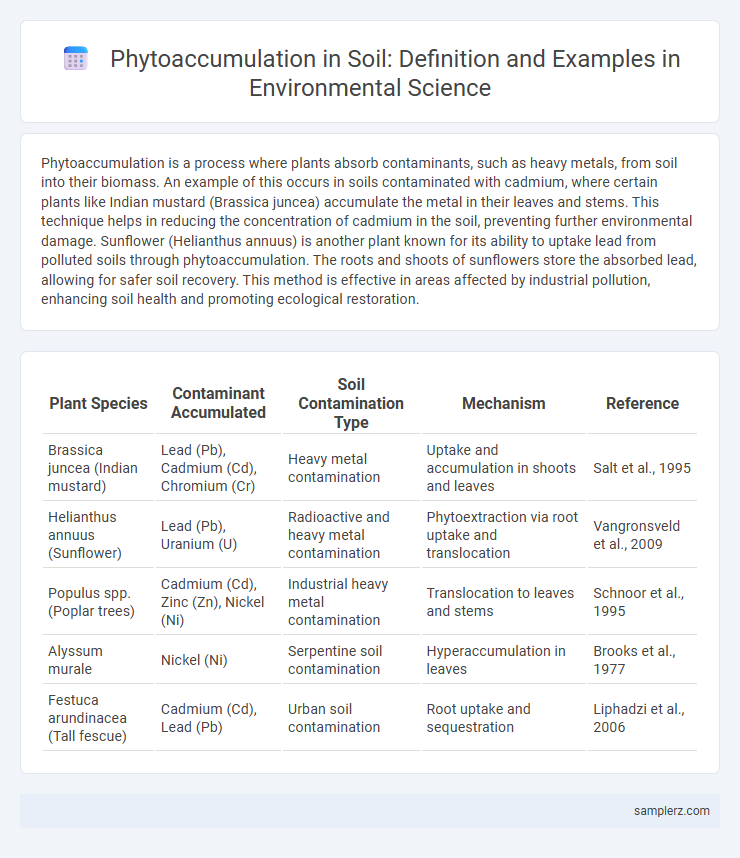Phytoaccumulation is a process where plants absorb contaminants, such as heavy metals, from soil into their biomass. An example of this occurs in soils contaminated with cadmium, where certain plants like Indian mustard (Brassica juncea) accumulate the metal in their leaves and stems. This technique helps in reducing the concentration of cadmium in the soil, preventing further environmental damage. Sunflower (Helianthus annuus) is another plant known for its ability to uptake lead from polluted soils through phytoaccumulation. The roots and shoots of sunflowers store the absorbed lead, allowing for safer soil recovery. This method is effective in areas affected by industrial pollution, enhancing soil health and promoting ecological restoration.
Table of Comparison
| Plant Species | Contaminant Accumulated | Soil Contamination Type | Mechanism | Reference |
|---|---|---|---|---|
| Brassica juncea (Indian mustard) | Lead (Pb), Cadmium (Cd), Chromium (Cr) | Heavy metal contamination | Uptake and accumulation in shoots and leaves | Salt et al., 1995 |
| Helianthus annuus (Sunflower) | Lead (Pb), Uranium (U) | Radioactive and heavy metal contamination | Phytoextraction via root uptake and translocation | Vangronsveld et al., 2009 |
| Populus spp. (Poplar trees) | Cadmium (Cd), Zinc (Zn), Nickel (Ni) | Industrial heavy metal contamination | Translocation to leaves and stems | Schnoor et al., 1995 |
| Alyssum murale | Nickel (Ni) | Serpentine soil contamination | Hyperaccumulation in leaves | Brooks et al., 1977 |
| Festuca arundinacea (Tall fescue) | Cadmium (Cd), Lead (Pb) | Urban soil contamination | Root uptake and sequestration | Liphadzi et al., 2006 |
Introduction to Phytoaccumulation in Soil
Phytoaccumulation in soil involves certain plants absorbing contaminants like heavy metals and pesticides through their roots, storing them in their tissues to reduce soil pollution. Species such as sunflowers, Indian mustard, and poplar trees are commonly employed for their ability to accumulate metals like lead, cadmium, and arsenic. This natural process offers an eco-friendly and cost-effective remediation technique for restoring contaminated soils and improving environmental health.
Key Mechanisms of Phytoaccumulation
Phytoaccumulation involves plants absorbing contaminants like heavy metals from soil through their roots, where metal ions are transported via the xylem to aerial parts. Key mechanisms include root uptake facilitated by metal-binding proteins and chelators, intracellular sequestration in vacuoles to reduce toxicity, and translocation to shoots for eventual removal through harvesting. This process leverages plant species such as Indian mustard and sunflower, known for their high metal accumulation capacity and tolerance.
Common Plants Used for Soil Phytoaccumulation
Sunflower (Helianthus annuus) and Indian mustard (Brassica juncea) are prominent examples of common plants used for soil phytoaccumulation due to their high capacity to absorb heavy metals like lead, cadmium, and arsenic. These plants accumulate contaminants in their biomass, enabling effective remediation of polluted soils without disturbing the soil structure. Their fast growth rates and extensive root systems enhance contaminant uptake, making them ideal for large-scale environmental cleanup projects.
Case Study: Sunflower and Heavy Metal Uptake
Sunflowers (Helianthus annuus) demonstrate effective phytoaccumulation by absorbing heavy metals such as lead and cadmium from contaminated soils. Studies reveal that sunflowers can reduce soil concentrations of these toxic metals by up to 30% over several growth cycles, enhancing soil remediation efforts. Their deep root system and high biomass production make them ideal candidates for phytoremediation of polluted environments.
Role of Indian Mustard in Lead Removal
Indian Mustard (Brassica juncea) plays a significant role in phytoaccumulation by effectively extracting lead from contaminated soils due to its high biomass and robust root system. Studies show that Indian Mustard can accumulate lead concentrations in its shoots up to 1,000 mg/kg, facilitating the removal of heavy metals and reducing soil toxicity. Its rapid growth and tolerance to heavy metal stress make it a preferred choice for bioremediation projects targeting lead-contaminated sites.
Willow Trees and Phytoaccumulation of Cadmium
Willow trees (Salix spp.) exhibit a strong capacity for phytoaccumulation of cadmium, effectively extracting this heavy metal from contaminated soil through their extensive root systems. Studies show that willow species can accumulate cadmium concentrations up to several hundred mg/kg in their biomass while promoting soil remediation. The use of willows in phytoremediation offers an eco-friendly and cost-effective strategy for reducing cadmium pollution in degraded environments.
Hyperaccumulator Species for Arsenic-Contaminated Soil
Pteris vittata, a well-known hyperaccumulator species, effectively extracts arsenic from contaminated soils through phytoaccumulation, significantly reducing arsenic levels. This fern can concentrate arsenic in its fronds up to several thousand milligrams per kilogram without suffering toxicity, making it highly suitable for remediation efforts. Field studies demonstrate Pteris vittata's capacity to restore arsenic-polluted agricultural lands, promoting safer soil environments and preventing arsenic entry into the food chain.
Phytoaccumulation of Petroleum Hydrocarbons by Alfalfa
Alfalfa (Medicago sativa) effectively phytoaccumulates petroleum hydrocarbons from contaminated soils, enhancing remediation efforts in petroleum-polluted environments. Its deep root system and high biomass production enable the uptake and sequestration of hydrocarbons, reducing soil toxicity. Studies indicate alfalfa's metabolic enzymes transform hydrocarbons into less harmful compounds, promoting soil recovery and ecosystem restoration.
Environmental Benefits of Phytoaccumulation in Remediation
Phytoaccumulation enhances soil remediation by using plants like Indian mustard (Brassica juncea) to absorb heavy metals such as lead, cadmium, and arsenic from contaminated sites. This process reduces soil toxicity, restores nutrient balance, and improves microbial activity, promoting healthier ecosystems. The use of phytoaccumulation lowers the need for chemical treatments, making it a cost-effective and sustainable solution for environmental cleanup.
Future Prospects of Phytoaccumulation Technologies
Phytoaccumulation technologies, exemplified by the use of hyperaccumulator plants such as Alyssum species for nickel-contaminated soils, show promising potential for large-scale soil remediation. Advances in genetic engineering aim to enhance metal uptake efficiency and tolerance, significantly accelerating detoxification processes. Integrating remote sensing and precision agriculture could optimize phytoaccumulation applications, ensuring sustainable and cost-effective restoration of polluted environments.

example of phytoaccumulation in soil Infographic
 samplerz.com
samplerz.com